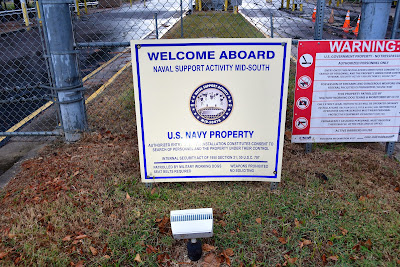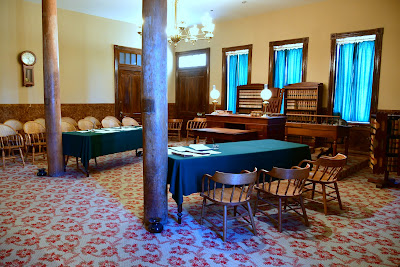The U.S. Navy called them "A-Schools" and that's where sailors learned electronics and a dozen other skills necessary for a Navy flight crewman or ground support person to know. I didn't do so well in the electronics component, but I did well enough in the myriad of other skills to eventually graduate with my class.
Millington, Tennessee, lies just north and east of the city of Memphis, which is located on the Mississippi River, and hosted the premier school where Navy men went after bootcamp to learn their various trades before going on active duty. Naturally, I had already been on active duty, so I possessed a certain stature just slightly above my incoming class.
My active duty time began in October, 1969. I reported to the Naval Air Station in Glenview, Illinois and was placed in a barracks with dozens of other sailors. We didn't have it too bad there as you only had to share your space with one other guy, and things were fairly private.
My first job was in the galley (kitchen) where I worked from sun-up to sun down for three months. After the galley I was posted to the flight line where I fueled and defueled jets and properller-driven planes as well as jocked airplanes and heliocopeters into and out of the hangers.This flightline job lasted for about three months and eventually involved me becoming a plane captain for the A4 Skyhawk jet fighters. This meant that I helped the pilot with his checklist before he taxied out to take off. I had to learn a myriad of hand signals that I held up for the pilot to see so he knew I had checked the necessary plane components.
So, not only had I been on active duty for six months when I arrived in Millington, but I had taken classes at John Muir High School for a couple of years in the California Cadet Corp program. This program was a sort of ROTC-like class. I knew how to march, I knew the various drill commmands, and I felt confident that I could march the men to their barracks on the first day. My stature as an "old salt" compared to the "boots," with their shaved heads and sunburns that covered the lower two thirds of their faces that hadn't been covered by their white Navy caps, was evident, and I was immediately put in charge of about sixty guys when we had formed up and the duty officer asked if anyone already had Navy experience.
This confidence was my undoing, of course, for as I marched the platoon down the main street and when I needed to issue a command for a "left wheel," I failed to do it in a timely manner. The plattoon, no doubt recently commanded by a non-commissioned officer at boot camp, dutifully kept marching straight ahead and right into a drainage ditch.
That goof got sorted out, but it was a serious blow to my credibility as you might guess. I don't remember ever being asked to march the boots anywhere after that.Then, for the next four months, I spent every day learning whatever a designated anti-submarine equipment operator had to learn to graduate. Oddly enough, we were not allowed to take notes in class as much of the material was designated "Top Secret" and could not leave the classroom. Being as how some of the material was pretty hard to fathom, it left most of us pretty dazed and confused much of the time.
Except one kid. This particular sailor, though only 18 years old, had already been employed at IBM before becoming a Navy man. He seemed to grasp every concept without breaking a sweat. I was so impressed with this guy that I asked him to do me a favor and adapt my portable radio/tape player to work inside my car. The radio was designed to run on either batteries OR on 110 AC. I don't remember the guy's name, but he took the radio apart, soldered in some wires, crafted a plug jack in my car's dashboard, and added a cord to the radio with an audio plugin cable. This radio hookup was in 1970, long before cars came with cassett tape players. Cars with 8-track players were becoming commonplace, but not cassettes.
Anyway, by the summer of 1970, I had finished my four months in Millington, Tennessee, had graduated without too many difficulties, and had moved on to the second phase of my training which was to take place in Willow Grove, Pennsylvania. The things I remember most about Millington were the RAIN and the BUGS. It rained, as the saying goes, like someone pouring water out of a boot, and the bugs -- especially mosquitos -- were giants and habitully flew in squadrons, which meant you always got bitten several times if your were bitten at all.Today Concetta and I crossed the border between Arkansas and Tennessee accompanied by a virtual deluge of rain. I'm not sure how Mother Nature knew I was coming, but obviously she wanted to welcome me back to Memphis with the very weather I had left there to escape.
When I was in Millington 52 years ago, I did have my car with me, unlike most of my barracks-mates. But access to the outside world was pretty regimented, and we didn't usually get to wander off unless we had a pass. But most of the boots had come without wheels and you can imagine how popular I was since I had a car on the base and most of the newbies didn't.
I had three buddies who I would load up and drive all over the immediate area. Their names escape me now, but we tended to leave the base and do everything together as far away from the base as possible. Since the Naval Air Station had about 11,000 sailors, you can imagine how disenchanted local businesses and residents were when the Navy "hit town."Though I don't remember much of what my shipmpates and I did when we would venture out into the world, I do remember one trip to the Mississippi River. I had never really been on the river before, and that particular day we all just sat under a tree and watched that massive flood of water charge by our vantage point. Truly, you have not experienced the awesome magnificence of nature until you have seen the mighty Mississippi, its turbid waters host to dozens of boats and barages as well as all manner of flotsom and jetson.
But the point of this narrative is not to recount my antics from a half century ago, but to detail my efforts to visit the Navy base in Millington since we would be traveling within fifteen miles of the front gate today. So it was that as we crossed the Mississippi into Tennessee and came abreast of Route 385 which runs from Interstate 40 to Route 51 north at Millington, we took the offramp and made our way toward what I hoped would be my own personal class reunion.
I really didn't know if they would let me on the base on the basis of my Navy ballcap and my story, but I thought it was probably worth a try. The first gate to the base we found was permanently locked and chained off, so we set off to circle the base and find another gate. Since we had to find a reasonable lunch stop anyway, it was easy to kill two birds with one stone.Finally, on what must have been the north side of the base, we found the main gate. Concetta was skeptical, but I told her that if you don't ask, most of the time you don't get. I turned on the blinker and made a right turn into the main gate approach.
When it was finally our turn to talk to the gate guard, and I told him that I had been stationed there 52 years before, he was decidedly unimpressed. "Do you have your Navy I.D.," he asked, eyeing the massinve 32-foot rig out of the corner of his eye. Naturally, I didn't have any sort of I.D. for an active service member so I told him no. We'll you have to have an I.D. to get beyond this point, he said. I told him I had my DD-214 onboard, but he said that wouldn't do.
At that point I asked the gate guard what he wanted me to do, and he said he'd have to call for instructions. After his call, he told me that there was a military policeman on his way to escort us to a spot were we could turn around. After that we had to leave the way we had come. "Sorry about that," he said. "But if you come back on Monday with your DD-214 and valid I.D., they might let you in to take a tour." Naturally we couldn't stay around to take the policeman up on his offer, but it was nice he gave us a potential way to accomplish our goal.Once we left the base I found a parking spot nearby and walked back to take a photo. It wasn't what I had hopped for, but it would have to do. Once the photo was accomplished, we sought out the nearest grocery store, did our shopping, had our lunch in the store parking lot, and once more hit the road. Interstate 40 was just fifteen miles east and it was fairly simple to find the onramp and continue our sojourn towards Nashville.
We hadn't had an opportunity to make reservations for a camp this evening, so we were glad when a roadside sign proclaimed that there was a camp in the town of Jackson just a half mile off the Interstate. We took the ramp, we found the camp named "Joy-O," and now we're esconced in just the perfect tree-shaded spot with all the hookups we desired. (see bottom three photos)
So, that's it for now. Tomorrow we're headed for Nashville where we have already arranged for a nice camp to host us tomorrow night. Monday we have made reservations to tour the gardens at President Andrew Jackson's home, The Hermitage. You know how both of us are just fanatics about great gardens, so that should be loads of fun.
And that's it for now. Concetta has left-over Chilli for dinner which contains ingredients from our home garden, so the evening is getting off to a good start. I'm going to do the dishes so she can put her feet up and rest, I wish you exciting adventures on your road of life! Ciao!









































